
A sepal is a part of the flower of angiosperms. Usually green, sepals typically function as protection for the flower in bud, and often as support for the petals when in bloom.

Paubrasilia echinata is a species of flowering plant in the legume family, Fabaceae, that is endemic to the Atlantic Forest of Brazil. It is a Brazilian timber tree commonly known as Pernambuco wood or brazilwood and is the national tree of Brazil. This plant has a dense, orange-red heartwood that takes a high shine, and it is the premier wood used for making bows for stringed instruments. The wood also yields a historically important red dye called brazilin, which oxidizes to brazilein.
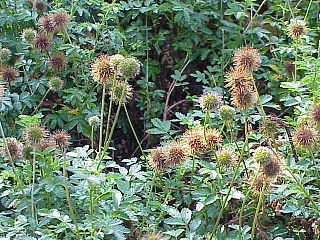
Acaena is a genus of about 60 species of mainly evergreen, creeping herbaceous perennial plants and subshrubs in the family Rosaceae, native mainly to the Southern Hemisphere, notably New Zealand, Australia and South America, but with a few species extending into the Northern Hemisphere, north to Hawaii and California.
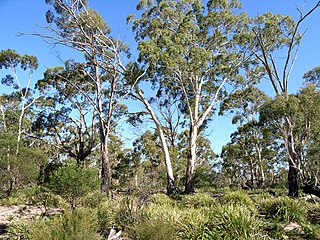
Eucalyptus viminalis, commonly known as the manna gum, white gum or ribbon gum, is a species of small to very tall tree that is endemic to south-eastern Australia. It has smooth bark, sometimes with rough bark near the base, lance-shaped to curved adult leaves, flower buds in groups of three or seven, white flowers and cup-shaped or hemispherical fruit.

Acacia implexa, commonly known as lightwood or hickory wattle, is a fast-growing Australian tree, the timber of which is used for furniture making. The wood is prized for its finish and strength. The foliage was used to make pulp and dye cloth.

Acaena novae-zelandiae, commonly known as red bidibid, bidgee widgee, buzzy and piri-piri bur, is a small herbaceous, prostrate perennial, native to New Zealand, Australia and New Guinea, of the family Rosaceae.
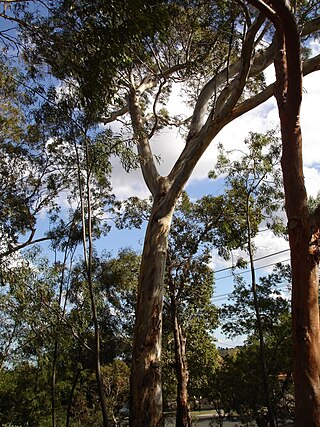
Eucalyptus leucoxylon, commonly known as yellow gum, blue gum or white ironbark, is a species of small to medium-sized tree that is endemic to south-eastern continental Australia. It has smooth yellowish bark with some rough bark near the base, lance-shaped or curved adult leaves, flower buds in groups of three and cylindrical, barrel-shaped or shortened spherical fruit. A widely cultivated species, it has white, red or pink flowers.

Acaena dumicola is a species of perennial plant found only in scrubby and rocky habitats at altitudes of between 300 and 1200 m in the South Island of New Zealand.

Acaena rorida is a species of mat-forming perennial plant known only from grassy uplands on the Mangaohane Plateau in the northwestern part of the Ruahine Range in the North Island of New Zealand.
Aechmea echinata is a species of flowering plant in the genus Aechmea. This species is endemic to the State of Bahia in eastern Brazil.

Acaena magellanica, commonly called buzzy burr or greater burnet, is a species of flowering plant whose range includes the southern tip of South America and many subantarctic islands.

Poa poiformis, commonly known as coast tussock-grass or blue tussock-grass, is a densely tufted, erect, perennial tussock grass, with distinctive blue-green leaves, that grows to about 1 m in height. Its inflorescences are arranged in a dense panicle up to 30 cm long. It is native to coastal southern Australia where it occurs along ocean foreshores, estuaries, dunes and cliffs. P. poiformis is also found on Kangaroo Island and Lord Howe Island.

Convolvulus erubescens, commonly known as blushing bindweed, or Australian bindweed, is a perennial herbaceous plant in the family Convolvulaceae that is endemic to Australia.

Lomandra filiformis, commonly known as wattle mat-rush, is a tussock forming perennial herb that is native to Australia. It is sparsely tufted, with strap-like leaves and yellow flowers. It grows in dry sclerophyll forest and grassy woodland, usually on well-drained rocky or sandy soils.
Gahnia radula, commonly known as the thatch saw-sedge is a tufted perennial sedge native to south-eastern Australia. The leaves are long, flat and rough, with sharp edges. It has a distinctive brown inflorescence, which darkens to black. It grows to 50–100 cm in height, spreads through its rhizomes and is found in eucalypt forest and grassy woodland.

Juncus pallidus, commonly known as the great soft-rushpale rush, giant rush, or leafless rush is a species of rush that is native to southern Australia, New Zealand, Norfolk Island, and Lord Howe Island. It is a vigorous, tufted, tussock-forming, rhizomatous perennial herb with culms growing to 70–135 cm in height. The inflorescence, which is 25–185 mm long, contains many straw coloured flowers, each with six floral segments. It is usually found in moist, nutrient-poor soils subject to periodic flooding, such as fresh and brackish waterways, including swamps, creek banks, lake edges and sand seeps.

Glycyrrhiza echinata is a species of flowering plant in the genus Glycyrrhiza, with various common names that include Chinese licorice, German licorice, and hedgehog licorice, Eastern European licorice, Hungarian licorice, Prickly licorice, and Roman licorice. It is used as a flavoring and medicinally, and to produce Russian and German licorice.
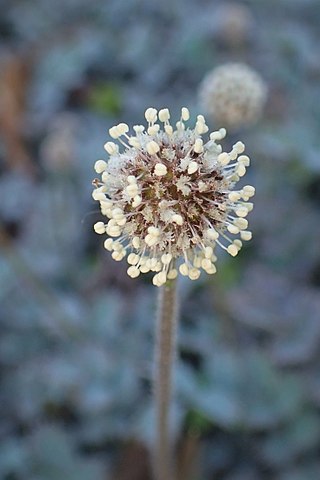
Acaena caesiiglauca is a species of Acaena. Aceana caesiiglauca grow to a height of 2–4 inches and a spread of about 2 ft. The flowers consist of reddish burrs and its foliage is described as a silky bluish grey.
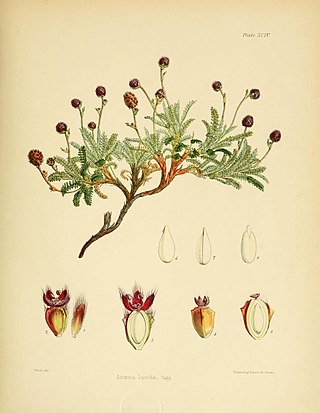
Acaena lucida is a small plant in the Rosaceae family, which is native to southern Chile, southern Argentina and the Falkland Islands.
Acaena tenera, the lesser burnet, is a plant in the rose family Rosaceae. It is native to Patagonia and some subantarctic islands.

















